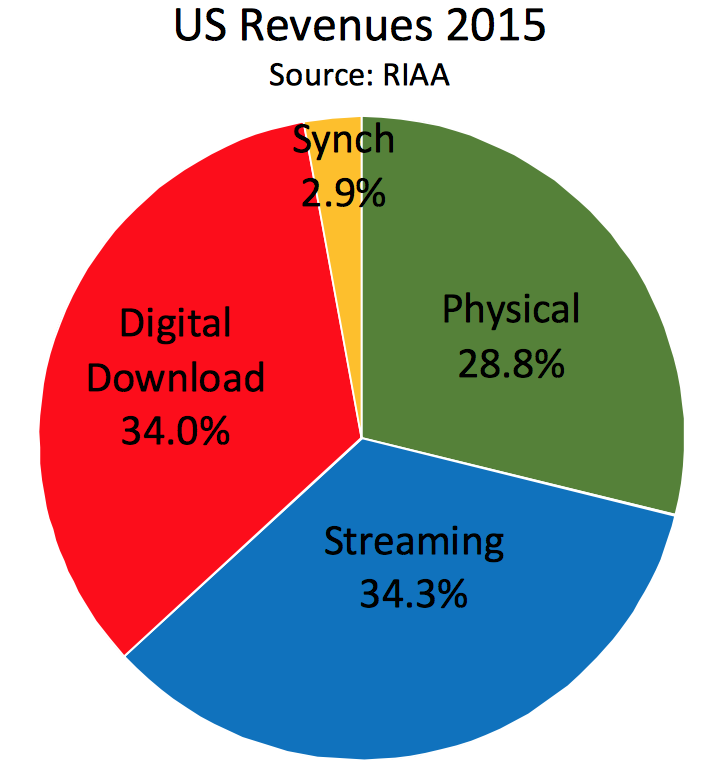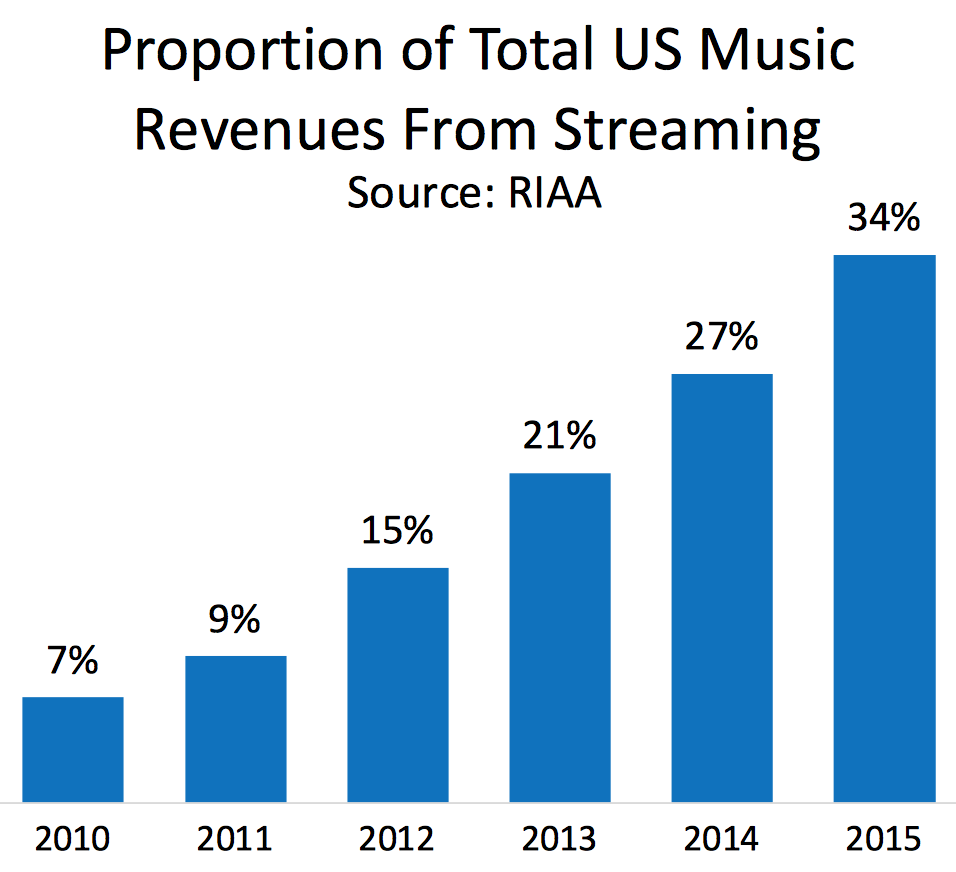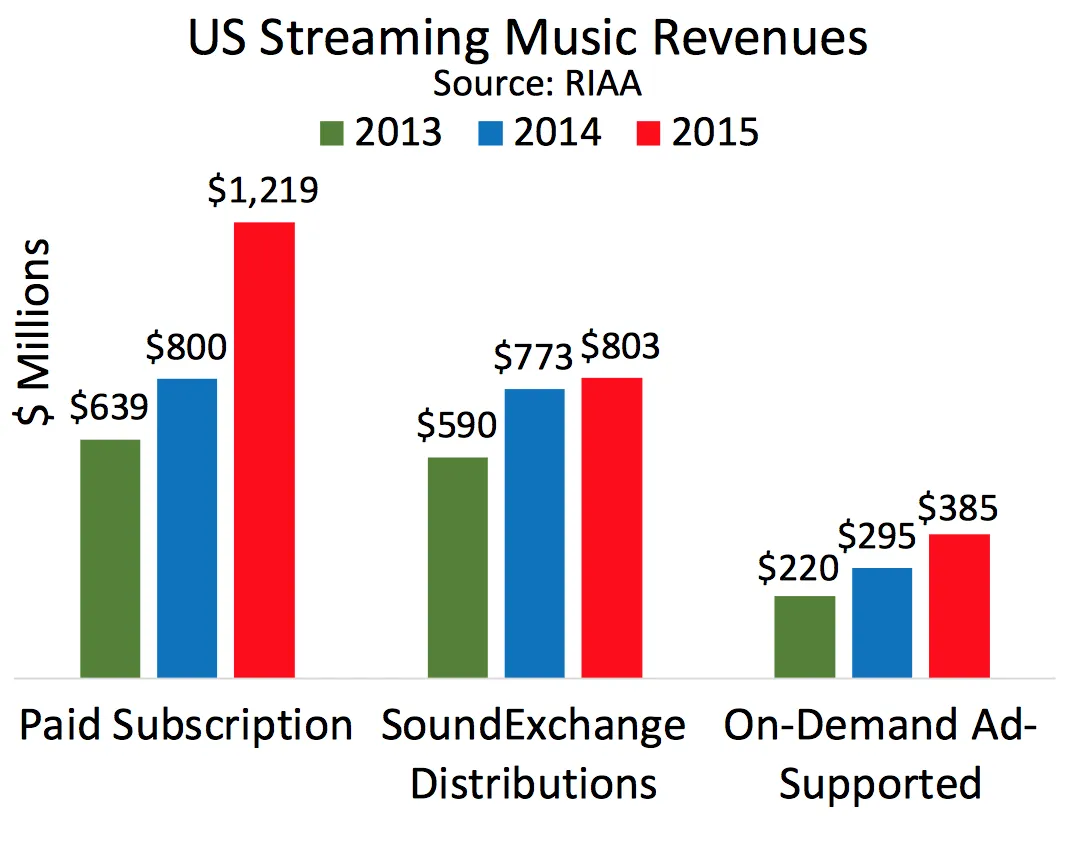Today, the RIAA released data confirming that streaming is the U.S. music industry’s single largest revenue-generator.
 For the first ever, streaming made up the largest component of the total U.S music industry revenue in 2015, which marks a major milestone for the format. The revenue mix in 2015 displays the ”most balanced revenue mix in recent history,” according to the group.
For the first ever, streaming made up the largest component of the total U.S music industry revenue in 2015, which marks a major milestone for the format. The revenue mix in 2015 displays the ”most balanced revenue mix in recent history,” according to the group.
Major format categories Streaming, Digital Downloads, and Physical all took approximately one-third of the total industry revenue piece.
But streaming accounted for the biggest share, with 34.3%.
This is partially offsetting digital and physical declines, or at least what’s left of them. ”The continued growth of revenues from streaming services offset declines in sales of digital downloads and physical product,” spun Joshua Friedlander, SVP of Strategic Data Analysis at the RIAA.
In 2014, physical product accounted for 33% of overall music industry revenue, and digital accounted for the other 67%. In 2015, as digital revenue grew 3% overall, revenue from physical product shrunk 3%.
Streaming is driving digital music revenue with unprecedented growth over the past five years. In 2010, Streaming made up 7% of the total music revenue, which slowly grew to 9% in 2011. From 2011, Streaming grew 6% year-on-year until 2014. Between 2014 and 2015, Streaming grew 7%, which is the largest percentage year-to-year growth so far.
This indicates that streaming is growing at a far stronger rate, and generating more income than ever before.
But streaming itself is a varied and complicated terrain. The streaming category includes revenues from a wide range of subscription services, both paid (i.e. Spotify, Apple Music, Tidal, etc.) and ad-supported (i.e. YouTube, ad-supported Spotify etc.) as well as streaming radio services (i.e. Pandora, SiriusXM).
Of that pie, paid subscription services were ”the biggest – and fastest growing – portion of the streaming market,” according to the data release. Power-players like Spotify, not to mention heavyweight entrants like Apple Music, are powering the paid growth.
 This could become a big future breadwinner. Between 2014 to 2015, paid subscription revenue increased from 7.7 million to 10.8 million, which is the highest year-to-year increase since 2012. Indeed, it’s no coincidence that paid subscription revenue increased at the highest rate between 2014 and 2015, thanks to a paid-only emphasis by both Apple and Tidal
This could become a big future breadwinner. Between 2014 to 2015, paid subscription revenue increased from 7.7 million to 10.8 million, which is the highest year-to-year increase since 2012. Indeed, it’s no coincidence that paid subscription revenue increased at the highest rate between 2014 and 2015, thanks to a paid-only emphasis by both Apple and Tidal
”Total streaming revenue exceeded $2 billion for the first time ever.”
The notion that streaming services have saved the music industry from deep decline, is one that Spotify CEO, Daniel Ek’s has been saying for a while. With streaming services racking up a recorded $2.4 billion in revenue in 2015, and taking the largest share of U.S, music industry revenue, it’s becoming harder to argue against this bold assertion.
The post Streaming: The Music Industry’s Largest Revenue Generator appeared first on Digital Music News.


